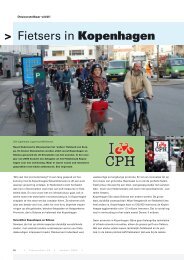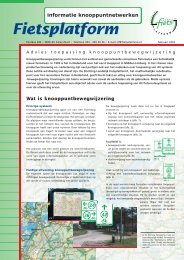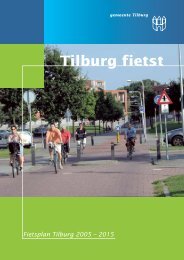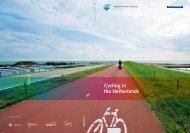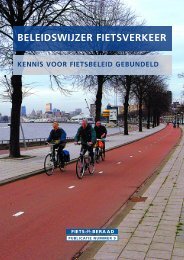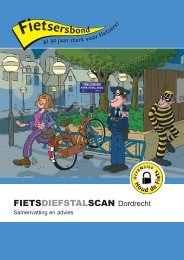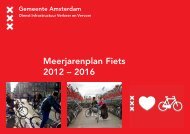Shoulders on rural access roads - Swov
Shoulders on rural access roads - Swov
Shoulders on rural access roads - Swov
Create successful ePaper yourself
Turn your PDF publications into a flip-book with our unique Google optimized e-Paper software.
SWOV Fact sheet<br />
<str<strong>on</strong>g>Shoulders</str<strong>on</strong>g> <strong>on</strong> <strong>rural</strong> <strong>access</strong> <strong>roads</strong><br />
Summary<br />
In a sustainably safe traffic system, uniformity of traffic facilities is a point of special interest. Uniformity<br />
ensures recognizability and predictability of (critical) traffic situati<strong>on</strong>s. The uniformity of <strong>rural</strong> <strong>access</strong><br />
<strong>roads</strong> can be increased by applying shoulders <strong>on</strong> both sides of the road; this creates a narrow single<br />
lane for motorised vehicles in the middle of the carriageway: a driving lane. <str<strong>on</strong>g>Shoulders</str<strong>on</strong>g> are marked with<br />
broken lines. The shoulders <strong>on</strong> either side of the driving lane can be used by cyclists if they are<br />
sufficiently wide. Studies indicate that this type of marking slightly increases road safety.<br />
Background and c<strong>on</strong>tents<br />
When redesigning <strong>rural</strong> <strong>roads</strong> according to the Sustainable Safety guidelines, 80 km/h <strong>roads</strong> with a<br />
minor traffic functi<strong>on</strong> in <strong>rural</strong> residential areas are c<strong>on</strong>verted into <strong>rural</strong> <strong>access</strong> <strong>roads</strong>. This road<br />
category is intended for use by all transport modes and has a speed limit of 60 km/h.<br />
In a sustainably safe traffic system, uniformity of traffic facilities is a point of special interest. Uniformity<br />
is a way of ensuring recognizability and predictability of (critical) traffic situati<strong>on</strong>s (see also the SWOV<br />
Fact sheet Recognizable road design . The uniformity of <strong>rural</strong> <strong>access</strong> <strong>roads</strong> can be increased by<br />
applying shoulders; this leaves a driving lane for motorized vehicles in the middle of the carriageway<br />
(see Figure 1). The present Fact sheet will discuss the requirements for the different types of <strong>rural</strong><br />
<strong>access</strong> road and the effects <strong>on</strong> traffic behaviour and road safety.<br />
Shoulder marking<br />
Shoulder Driving lanes Shoulder<br />
Carriageway width<br />
Figure 1. Driving lanes with shoulders; cross secti<strong>on</strong> (left) and view from above (right).<br />
How many casualties <strong>on</strong> 60 km/h <strong>access</strong> <strong>roads</strong>?<br />
Table 1 shows that in 1998 there were 11 registered fatalities <strong>on</strong> Dutch 60 km/h <strong>rural</strong> <strong>access</strong> <strong>roads</strong>. In<br />
2009 there were 82 fatalities; an increase by a factor of 7. This amounts to an increase from about 1%<br />
of all registered road deaths in the Netherlands in the late 1990s to about 12% <strong>on</strong>e decade later. This<br />
increase seems to be almost entirely due to the increase in 60 km/h <strong>roads</strong>. In 1998, there was an<br />
estimated 2,100 km of 60 km/h <strong>access</strong> <strong>roads</strong>; in 2008 this was approximately 35,400 km (Weijermars<br />
& Van Schagen, 2009), an increase by a factor of 16. This means that the casualty density, here the<br />
number of road fatalities per 1,000 kilometres road length, went down by 62% from 5.2 in 1998 to 2.0<br />
in 2008. Too little reliable data is available about the traffic volumes <strong>on</strong> these <strong>roads</strong> to allow any<br />
statements about the crash rate.<br />
SWOV Fact sheet 1 © SWOV, Leidschendam, the Netherlands<br />
August 2010<br />
Reproducti<strong>on</strong> is <strong>on</strong>ly permitted with due acknowledgement
1998 1999 2000 2001 2002 2003 2004 2005 2006 2007 2008 2009<br />
Intersecti<strong>on</strong> 3 1 2 4 5 9 11 9 15 17 17 11<br />
Road secti<strong>on</strong> 8 9 21 20 23 27 31 45 46 52 51 71<br />
Total 11<br />
(1%)<br />
10<br />
(1%)<br />
23<br />
(2%)<br />
24<br />
(2%)<br />
28<br />
(3%)<br />
36<br />
(4%)<br />
42<br />
(5%)<br />
54<br />
(7%)<br />
61<br />
(8%)<br />
69<br />
(10%)<br />
68<br />
(10%)<br />
Table 1. Registered numbers of fatalities <strong>on</strong> 60 km/h <strong>roads</strong> in the period 1998-2009 in the<br />
Netherlands, and the percentage of the total number of fatalities <strong>on</strong> all <strong>roads</strong>. Source: Dutch Ministry<br />
of Transport- BRON.<br />
82<br />
(12%)<br />
What are the guidelines for <strong>access</strong> <strong>roads</strong> with shoulders?<br />
According to the Dutch guidelines, the <strong>rural</strong> <strong>access</strong> <strong>roads</strong> can be subdivided into <strong>roads</strong> of type I<br />
(carriageway width of 4.50-6.20 m) and type II (carriageway width of 2.50-4.50 m) (Table 2). From the<br />
Sustainable Safety point of view, the 60 km/h speed limit <strong>on</strong> <strong>rural</strong> <strong>access</strong> <strong>roads</strong> is in fact too high for<br />
the mixing of different transport modes. For safe mixing the maximum speed should not be higher than<br />
30 km/h. To make the situati<strong>on</strong> as safe as possible, applying a single driving lane for car traffic in both<br />
directi<strong>on</strong>s in the middle of the carriageway <strong>on</strong> type I <strong>access</strong> <strong>roads</strong> is recommended (CROW, 2002;<br />
see also Figure 1). Such a visual narrowing is intended to make motor vehicles drive slower and more<br />
in the middle of the carriageway. The driving lane is marked by broken lines. The spaces between the<br />
driving lane and the edge of the carriageway <strong>on</strong> either side are called shoulders. <str<strong>on</strong>g>Shoulders</str<strong>on</strong>g> provide<br />
more room to correct steering errors, thus reducing the risk of going off the road. We expect that this<br />
will reduce the damage to road shoulders, which, in its turn, can substantially lower the maintenance<br />
costs. The width of the shoulder and the type of edge marking determine the name that is used for the<br />
shoulder (CROW, 2004, 2006):<br />
− Diverging lane, intended for motorized vehicles when overtaking or when passing <strong>on</strong>coming traffic<br />
(marked with broken line in a ratio of 1 m line – 3 m open, width of 0.25-0.40 m);<br />
− Auxiliary lane, intended for use by bicycles (marked with broken line in a ratio of 1 m line – 1 m<br />
open, width of 1.25-1.50 m);<br />
− Bicycle lane (marked with broken line in a ratio of 1 m line – 1 m open, width of 1.50-2.00 m and<br />
red in colour.<br />
Characteristic* Rural <strong>access</strong> road type I Rural <strong>access</strong> road type II<br />
Speed limit 60 km/h 60 km/h<br />
Number of lanes One One<br />
Carriageway width 4.50 – 6.20 m
allowed to use it for halting or parking <strong>on</strong> or next to it. The Design manual for bicycle traffic advises<br />
against positi<strong>on</strong>ing parking spaces next to the bicycle lane.<br />
Separate bicycle and moped tracks do not c<strong>on</strong>tribute to the recognizability of the <strong>access</strong> road which<br />
has mixing of all transport modes as <strong>on</strong>e of its important Sustainable Safety features. Only if the daily<br />
traffic volume exceeds 2,000 to 3,000 motor vehicles per day, does CROW (2006) recommend a<br />
separate bicycle track. When redesigning the current situati<strong>on</strong> (with a smaller traffic volume), the<br />
bicycle and moped lanes can be c<strong>on</strong>verted into n<strong>on</strong>-compulsory bicycle lanes, with mopeds <strong>on</strong> the<br />
carriageway.<br />
According to the recommendati<strong>on</strong>s in the Road design manual (CROW, 2002), <strong>access</strong> <strong>roads</strong> of type II<br />
are too narrow (< 4.5 m) for a marked driving lane and therefore have no edge markings. A broken<br />
edge marking can be applied here (in the ratio of 3-1; 3 metres line, 1 metre open) in dangerous<br />
bends or when vehicles often go off the road.<br />
On both types of <strong>access</strong> road, a centre line marking may <strong>on</strong>ly be applied in excepti<strong>on</strong>al cases: <strong>on</strong>ly in<br />
a bend for safety reas<strong>on</strong>s and <strong>on</strong>ly <strong>on</strong> short stretches.<br />
What proporti<strong>on</strong> of the <strong>access</strong> <strong>roads</strong> have been fitted with shoulders?<br />
To improve its insight in the layout of <strong>roads</strong> in the Netherlands, SWOV in early 2009 held a survey<br />
am<strong>on</strong>g the Dutch road authorities (Weijermars & Van Schagen, 2009). This showed that in 2008,<br />
35,400 km (63%) of the approximately 56,000 km of n<strong>on</strong>-urban <strong>roads</strong> categorized as <strong>access</strong> <strong>roads</strong><br />
indeed had a 60 km/h speed limit. The speed limit <strong>on</strong> the remaining <strong>roads</strong> generally (still) was 80<br />
km/h. According to the road authorities approximately three-quarters of the <strong>access</strong> <strong>roads</strong> with a 60<br />
km/h limit had markings according to the Dutch Essential Recognizability Characteristics (CROW,<br />
2004), which means that <strong>roads</strong> wider than 4.5 m had broken edge markings.<br />
How do shoulders affect the number of road casualties?<br />
To assess the 60 km/h projects a crash study (with before-and-after data plus reference areas)was<br />
performed in twenty z<strong>on</strong>es with an 850 km total road length (Beenker, 2004). At road secti<strong>on</strong>s, the<br />
number of crashes with casualties (fatalities, serious road injuries and slightly injured) appears to be<br />
almost <strong>on</strong>e-fifth lower. The carriageway width of the <strong>roads</strong> included in this study varied between 3 and<br />
5 m. Only those <strong>roads</strong> with a surface width of between 4.5 en 5 m were likely to have been fitted with<br />
shoulders. Therefore it is not absolutely certain for which share of the casualty reducti<strong>on</strong> these <strong>roads</strong><br />
with shoulders are resp<strong>on</strong>sible. It should be noted that the number of casualties at intersecti<strong>on</strong>s even<br />
decreased by almost 50%, probably as a result of the c<strong>on</strong>structi<strong>on</strong> of raised intersecti<strong>on</strong>s at hazardous<br />
locati<strong>on</strong>s. Although this evaluati<strong>on</strong> study indicates that changing an 80 km/h road into an <strong>access</strong> road<br />
has a positive effect <strong>on</strong> the number of road casualties, it is not possible to make any statement about<br />
the specific c<strong>on</strong>tributi<strong>on</strong> of shoulder and driving lane.<br />
How do shoulders influence driving behaviour?<br />
SWOV performed two observati<strong>on</strong> studies at road secti<strong>on</strong>s with and without shoulders, so that a little<br />
is known about the effects <strong>on</strong> the behaviour of both drivers and cyclists. It should be noted that in both<br />
studies the investigated shoulders were intended for use by cyclists – and were therefore wider than a<br />
diverging lane – but that they were too narrow for a n<strong>on</strong>-compulsory lane according to the present<br />
definiti<strong>on</strong> in the guidelines.<br />
The first study (Van der Kooi & Heidstra, 1999) compared <strong>roads</strong> with and <strong>roads</strong> without shoulders. On<br />
average, cars <strong>on</strong> <strong>roads</strong> with shoulders appeared to drive somewhat slower than cars <strong>on</strong> <strong>roads</strong> without<br />
shoulders. At the same time, however, it was shown that the space between cyclists and passing cars<br />
was slightly smaller <strong>on</strong> <strong>roads</strong> with shoulders, than <strong>on</strong> those without.<br />
The sec<strong>on</strong>d study (Van der Kooi & Dijkstra, 2003) was a before-and-after study. The driving speed<br />
and the lateral positi<strong>on</strong> of cars were observed before and after shoulders were applied. The findings<br />
broadly matched those in the previous study. A carriageway with shoulders has been found to have a<br />
channelling effect which both drivers and cyclists seem to accept. These are positive effects. Cyclists<br />
use 'their own' strip and usually keep somewhat more distance from the road edge than they did<br />
before a shoulder had been applied. Drivers also keep slightly more distance from the road edge when<br />
shoulders are present. When passing a cyclist they often choose not to cross the shoulder <strong>on</strong> the<br />
other side of the road. At the same time, this means that when drivers overtake a cyclist <strong>on</strong> a n<strong>on</strong>compulsory<br />
bicycle lane they are often closer to the cyclist. To what extent the distance being a few<br />
centimetres narrower is dangerous is hard to say. In most cases, the average driving speed goes<br />
down by a few km/h due to the edge lanes. This is a positive development that, however limited it may<br />
SWOV Fact sheet 3 © SWOV, Leidschendam, the Netherlands<br />
August 2010<br />
Reproducti<strong>on</strong> is <strong>on</strong>ly permitted with due acknowledgement
e, has a positive effect <strong>on</strong> nearly all crash types (see also SWOV Fact sheet The relati<strong>on</strong> between<br />
speed and crashes).<br />
As was menti<strong>on</strong>ed earlier, the shoulders that were investigated were narrower than is now the advice<br />
for n<strong>on</strong>-compulsory lanes. A slightly wider strip may perhaps have a somewhat more positive effect <strong>on</strong><br />
driving speed and distance between car and cyclist, but this would require further investigati<strong>on</strong>.<br />
Furthermore, Aarts & Davidse (2007) found that red shoulders – in their study without the bicycle<br />
marking – increase the distincti<strong>on</strong> of <strong>access</strong> <strong>roads</strong> as opposed to other road categories and raise the<br />
correct expectati<strong>on</strong>s about the possible presence of cyclists.<br />
Other than the studies into shoulders <strong>on</strong> 60 km/h <strong>roads</strong>, there has been much internati<strong>on</strong>al research<br />
into the effects of line markings <strong>on</strong> driving behaviour. A meta-analysis of these types of studies<br />
(Davidse et al., 2004) shows that edge markings have a positive effect <strong>on</strong> the lateral positi<strong>on</strong> of cars<br />
<strong>on</strong> the road, and limit the risk of going off the road and damaging the road shoulder. An unwanted<br />
effect is that the good visual guidance of line markings encourages drivers to use a higher speed.<br />
Broken lines offer (somewhat) less visual guidance than solid lines and also give a clearer impressi<strong>on</strong><br />
of the driven speed. If, like <strong>on</strong> <strong>access</strong> <strong>roads</strong>, the purpose is speed reducti<strong>on</strong>, broken lines are<br />
preferred.<br />
C<strong>on</strong>clusi<strong>on</strong><br />
The uniformity and recognizability of <strong>rural</strong> <strong>access</strong> <strong>roads</strong> is increased by shoulders at both sides of the<br />
road, thus creating a single driving lane for motorized vehicles in the middle of the carriageway. The<br />
marking of the shoulders c<strong>on</strong>sists of broken lines. The two shoulders can be used by bicycles if they<br />
are sufficiently wide. Such strips are called auxiliary lanes intended for bicycles. If the surface is<br />
marked with a bicycle symbol it is called a bicycle lane. Bicycle lanes have a legal status and are<br />
preferably carried out in red asphalt. Research findings indicate a slight road safety improvement as a<br />
result of edge markings.<br />
Publicati<strong>on</strong>s and sources<br />
(SWOV reports in Dutch have an English summary)<br />
Aarts L.T &. Davidse, R.J. (2007). Herkenbare vormgeving van wegen; Eindrapport van de<br />
herkenbaarheidsprojecten in het SWOV-programma 2003-2006. R-2006-18. SWOV, Leidschendam.<br />
[in Dutch]<br />
Beenker, N.J. (2004). Evaluatie 60 km/uur projecten; Eindrapport. In opdracht van de Unie van<br />
Waterschappen. VIA Advies in verkeer & informatica, Vught.<br />
CROW (2002). Handboek weg<strong>on</strong>twerp wegen buiten de bebouwde kom: erftoegangswegen.<br />
Publicatie 164d. CROW, Ede.<br />
CROW (2004). Richtlijn essentiële herkenbaarheidkenmerken van weginfrastructuur: wegwijzer voor<br />
implementatie. Publicatie 203. CROW, Ede.<br />
CROW (2006). Ontwerpwijzer fietsverkeer. Publicatie 230. CROW, Ede.<br />
Davidse, R.J., Driel, C.J.G van & Goldenbeld, Ch. (2004). The effect of altered road markings <strong>on</strong><br />
speed and lateral positi<strong>on</strong>: a meta-analysis. R-2003-31. SWOV, Leidschendam. [In English]<br />
Kooi, R.M. van der & Dijkstra A. (2003). Enkele gedragseffecten van suggestiestroken op smalle<br />
<strong>rural</strong>e wegen. R-2003-17. SWOV, Leidschendam. [in Dutch]<br />
Kooi, R.M. van der & Heidstra, J. (1999). Effect van kantstroken op verkeersgedrag. R-99-25. SWOV,<br />
Leidschendam. [in Dutch]<br />
Weijermars, W.A.M. & Schagen, I.N.L.G. van (2009). Tien jaar Duurzaam Veilig; Verkeersveiligheidsbalans<br />
1998-2007. R-2009-14. SWOV. Leidschendam.<br />
SWOV Fact sheet 4 © SWOV, Leidschendam, the Netherlands<br />
August 2010<br />
Reproducti<strong>on</strong> is <strong>on</strong>ly permitted with due acknowledgement


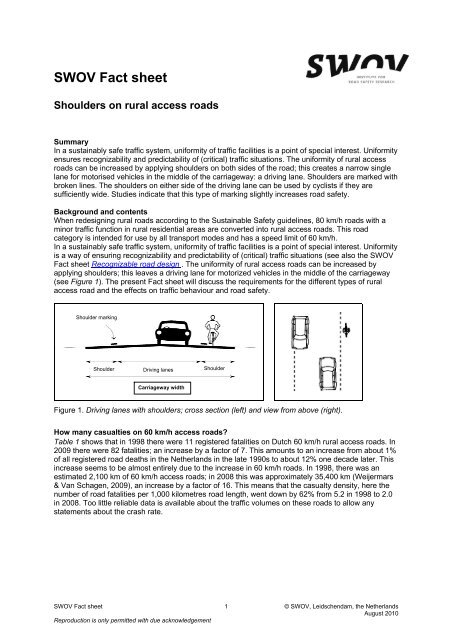
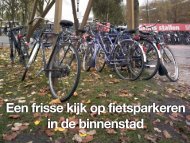
![[plein] - Fietsberaad](https://img.yumpu.com/20829245/1/184x260/plein-fietsberaad.jpg?quality=85)
